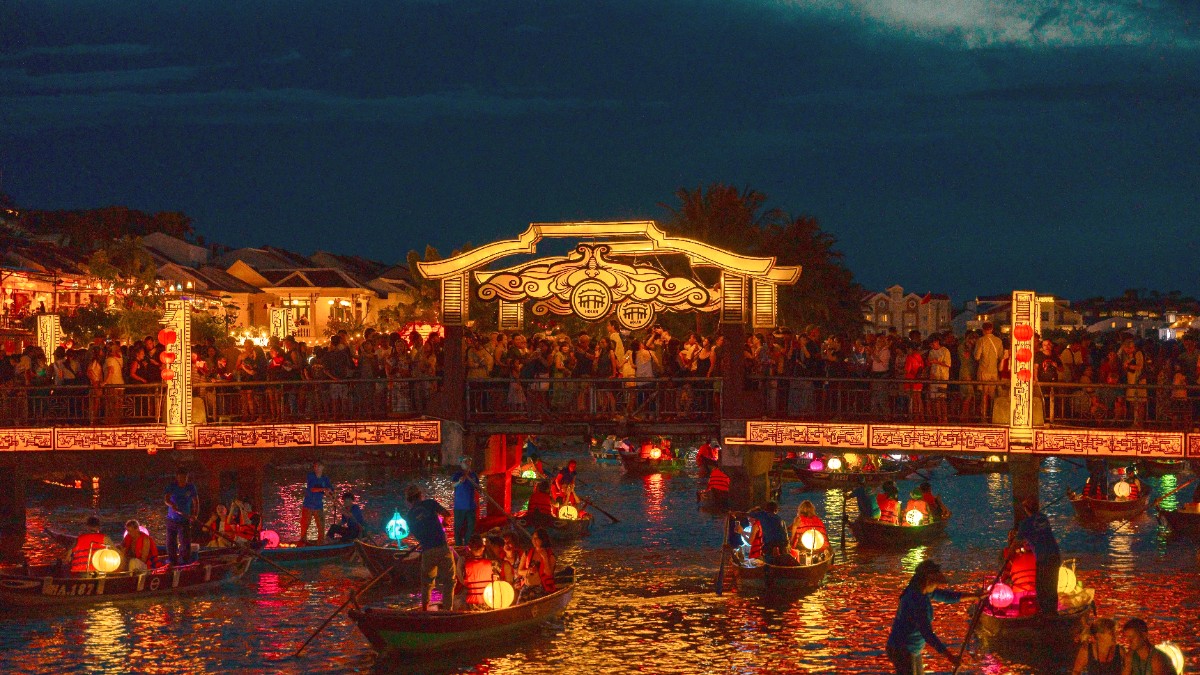
Central Vietnam, Vietnam
Hoi An sits on Vietnam's central coast, located in Quang Nam Province. The Thu Bon River flows through the town, eventually meeting the East Sea, also known as the South China Sea. This riverine and coastal setting shaped Hoi An’s destiny as a trading port for centuries.
Hoi An's story begins in the 15th century as a trading port, drawing merchants from China, Japan, India, and European countries. During the 17th and 18th centuries, it grew into one of Southeast Asia's busiest trading centers. Goods like silk, ceramics, and spices moved through its port.
The town’s architecture directly mirrors this multicultural past, with Chinese shophouses, Japanese-designed bridges, and French colonial buildings standing side-by-side. Hoi An escaped major destruction during the 20th-century wars, preserving its old-world charm. Today, it is a living museum, offering a look into a bygone era of global trade and cultural exchange.
Hoi An experiences a tropical climate with two distinct seasons: a dry season (February to August) and a wet season (September to January). The most comfortable weather for sightseeing typically occurs from February to April, with pleasant temperatures and low rainfall.
Dry Season (February to August): This period has sunny days and low humidity. Temperatures are around 25-30°C (77-86°F) from February to April, rising to 30-35°C (86-95°F) from May to August. Wet Season (September to January): This season has higher humidity and heavy rain, especially from September to November, when typhoons are possible. Temperatures range from 24-28°C (75-82°F).
Ideal weather, but expect higher prices and larger crowds.
Warm for beaches (May-Aug), cooler with some rain (Dec-Jan). Fewer crowds, better deals.
Lowest prices. High risk of heavy rain, flooding, and typhoons.
September to November. Strong winds and significant flooding are possible.
Beach activities (Mar-Aug). Ancient Town/cycling (Feb-Apr). Lantern Festival (14th lunar day, dry season).
Most foreign visitors acquire a visa to enter Vietnam. Several visa options cater to different needs.
E-visa: Citizens of 80 countries acquire an e-visa online through the official National Web Portal of Immigration of Vietnam. It allows a single entry and up to 90 days. Visa on Arrival (VOA): You acquire an approval letter from a travel agency like IVisa or VisaHQ before your trip. The actual visa stamp is issued at a Vietnamese international airport. Traditional Visa: Acquire this from a Vietnamese Embassy or Consulate for those not eligible for e-visa/VOA or for longer/multiple entries. Visa Exemptions: Citizens from certain countries may enter without a visa for short periods; check official Vietnamese government sources for current rules.
Passport: Valid for at least six months beyond your departure date. Passport Photos: Two recent passport-sized photos for VOA/traditional visas, digital upload for e-visa. Visa Approval Letter: Printout for VOA. Application Forms: Complete necessary forms. Entry/Exit Form: Possibly fill out upon arrival. E-visa Fee: US$25 for single entry, 90-day. VOA Stamping Fee: US$25 for single entry, US$50 for multiple entries, cash preferred in USD at airport. Immigration: Proceed to counters at Da Nang International Airport (DAD); VOA users first visit "Visa on Arrival" counter.
No specific vaccination certificates are generally required for entry. If you travel from a Yellow Fever risk area, a Yellow Fever vaccination certificate may be requested. Always check latest health advisories.
Prices vary by travel style, from budget-friendly options to luxury experiences.
Currency: Vietnamese Dong (VND). Exchange Rate: Around 25,000 VND to 1 USD. Exchange foreign currency at banks, authorized money changers, or gold shops. ATMs are widely available. Credit Cards: Larger hotels, restaurants, and shops accept credit cards. Cash is common for smaller purchases. Keep small VND denominations for street vendors, taxis, and tips.
Daily cost: $25 - $50 (Hostel, street food, bicycle)
Daily cost: $50 - $100 (Guesthouse/hotel, local restaurants, scooter)
Daily cost: $100+ (Luxury resort, fine dining, private car)
Tipping is not a traditional practice in Vietnam. It becomes more appreciated in areas with many visitors like Hoi An.
Hoi An is generally a safe destination. Diligent preparation for health and safety will contribute to a pleasant journey.
Consult your doctor before your trip about vaccinations. Yellow Fever vaccination is only for arrivals from specific risk countries. Recommended vaccinations often include Hepatitis A & B, Typhoid, Tdap, MMR, Japanese Encephalitis (for rural areas during mosquito season), and Rabies (if animal exposure is likely).
Traveler's Diarrhea (drink bottled water, wash hands, eat fresh cooked food). Dengue Fever (mosquito-borne, use Insect repellent with DEET, long sleeves). Heatstroke/Dehydration (stay hydrated, seek shade). Sunburn (use high-SPF Sunscreen, hat).
Tap water is not safe for drinking; stick to bottled water. Consider a LifeStraw or a Water purification bottle. Eat fresh, hot street food from busy stalls. Avoid raw or undercooked meat/seafood. Peel fruits.
Hoi An is safe. Petty crime (pickpocketing, bag snatching) can occur in crowded areas. Stay alert. Scams involve inflated taxi fares (use metered or Grab), fake tour operators, and overcharging. Bargain politely. Pacsafe offers anti-theft solutions.
Hoi An has a provincial hospital. For serious medical emergencies, transfer to Da Nang (30km) is recommended. Da Nang has larger, modern hospitals like Hoan My Da Nang Hospital. Several private clinics and pharmacies exist in Hoi An for minor ailments.